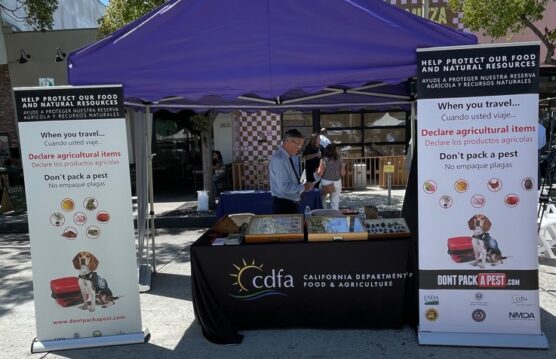The United States Department of Agriculture’s Animal and Plant Health Inspection Service, and the California Department of Food and Agriculture in collaboration with county agricultural commissioners have announced after a year of hard work all populations of invasive fruit flies have been eradicated from California.
The quarantine for the Tau fruit fly in the Santa Clarita Valley was lifted in July.
The SCV first learned about the Tau fruit fly quarantine and the need not to move backyard fruit out of the SCV in February.
This significant achievement that was described as “a testament to the hard work of the agencies involved and the critical support from the public” was celebrated at a press conference held at the Culver City Farmers Market.
“Invasive fruit flies are among the most destructive and costly pests globally, threatening more than 400 species of fruits and vegetables, including many of California’s most valuable crops such as oranges, grapes, mangoes, blueberries, and tomatoes,” said USDA Under Secretary for Marketing and Regulatory Programs Jenny L. Moffitt. “The eradication of these pests marks a major victory for California’s agricultural economy.”
The joint eradication effort addressed infestations from five introduced species: Oriental (Bactrocera dorsalis), Tau (Zeugodacus tau), Queensland (Bactrocera tryoni), Mexican (Anastrepha ludens) and Mediterranean (Ceratitis capitata) fruit flies. With this successful eradication, quarantines have been lifted across Contra Costa, Los Angeles, Orange, Sacramento, San Bernadino, Santa Clara, San Diego, Riverside and Ventura Counties, freeing thousands of acres of commercial agriculture from restrictions.
The 2023 invasive fruit fly outbreak was unprecedented, marking the worst of its kind in CDFA’s 100-year history. The outbreak included first-ever quarantines for Tau and Queensland fruit flies in the United States and Western Hemisphere.
In response, USDA Secretary Thomas Vilsack allocated $103.5 million from the Commodity Credit Corporation to APHIS, enabling swift and effective action against the outbreak.
The Animal and Plant Health Inspection Service deployed hundreds of employees to join forces with CDFA and the agricultural commissioners for trapping, fruit removal, and survey activities. The team leveraged advanced eradication techniques, including the release of sterile Mediterranean and Mexican fruit flies to disrupt the reproduction of these invasive species. The cooperative effort also included the application of an organic treatment called Spinosad and the development of new regulatory treatments, allowing the safe shipment of commercial citrus out of quarantined areas.
California Department of Food and Agriculture Secretary Karen Ross emphasized the importance of public cooperation in these efforts.
“We are proud of what we have accomplished with the help of California residents. Your support was vital to eradicating these pests and remains essential in protecting our food supply and natural resources from future invasive threats,” said Ross.
Ross also outlined steps that the public can take to help prevent future infestations:
Declare agricultural products, including fruits or vegetables, to U.S. Customs and Border Protection officials when returning from overseas.
Familiarize yourself with local quarantines via the CDFA website at www.cdfa.ca.gov/plant/ and avoid moving or mailing homegrown fruit within or from quarantine areas.
Contact the USDA State Plant Health Director at www.aphis.usda.gov/contact/plant-health about the legal requirements before shipping agricultural goods interstate or from overseas.
Receiving agricultural goods from foreign sources can spread invasive pests.
Allow agricultural officials access to your property for fruit fly trap servicing, pest detection, or to remove fruit when necessary.
Avoid composting fruit or vegetables within quarantine areas.
Report suspicious pests such as maggots inside of your fruit to your local county agricultural commissioner’s office or to CDFA’s pest hotline at 1-800-491-1899. Please alert either office if a fruit fly trap on your property has been damaged or moved.
For online reporting, visit www.cdfa.ca.gov/plant/reportapest/ or email reportapest@cdfa.ca.gov. You may also contact your local county agriculturalcommissioner’s office at www.cdfa.ca.gov/exec/county/countymap/.
“We are deeply grateful for the public’s continued vigilance in keeping California free from invasive species. Together, we have turned one of our greatest challenges into a triumph,” said Ross.
For more information on invasive insects or plant diseases, visit HungryPests.com.
Like this:
Like Loading...
Related





 Tweet This
Tweet This Facebook
Facebook Digg This
Digg This Bookmark
Bookmark Stumble
Stumble RSS
RSS




























REAL NAMES ONLY: All posters must use their real individual or business name. This applies equally to Twitter account holders who use a nickname.
0 Comments
You can be the first one to leave a comment.